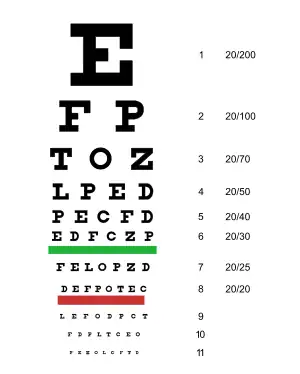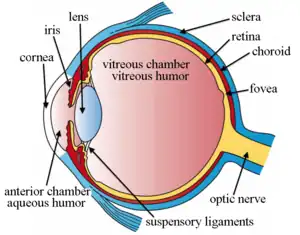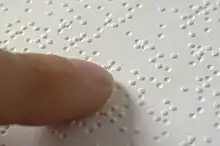Childhood blindness
| Childhood blindness | |
|---|---|
 | |
| Snellen chart used to determine visual acuity | |
| Causes | Genetic disorder, Infection[1] |
| Diagnostic method | Pupillary reflex(among others)[2] |
| Prevention | Vitamin A supplement[3] |
Childhood blindness is an important cause contributing to the burden of blindness.[4] Blindness in children can be defined as a visual acuity of <3/60 in the eye with better vision of a child under 16 years of age.[5] This generally means that the child cannot see something 10 feet (about 3 meters) away, that another child could see if it was 200 feet (about 60 meters) away. [6]
Causes

There are many causes of blindness in children. Blindness may be due to genetic mutations, birth defects, premature birth, nutritional deficiencies, infections, injuries, and other causes. Severe retinopathy of prematurity (ROP), cataracts, Vitamin A deficiency and refractive error are also causes.[7][8]
The most frequently affected parts of the eyes are:[9][10]
- Whole globe (36%)
- Cornea (36%)
- Lens (11%)
- Retina (6%)
- Optic nerve (5%)
- Uvea (2%)
Mechanism
Childhood blindness has many causes, and each cause has its own method of damaging the eyes.[11] Leber congenital amaurosis primarily affects the retina, and typically severe visual impairment begins in infancy. Mutations in Aryl hydrocarbon receptor interacting protein like-1 have been linked to Leber congenital amaurosis (LCA).[12]
Diagnosis
The diagnosis of childhood blindness is done via methods to ascertain the degree of visual impairment in the affected child doing so via dilating eye drops and the proceeding eye exam.
Prevention

Vitamin A deficiency is a top cause of preventable childhood blindness.[13] For children who have measles, there is insufficient evidence to determine if vitamin A is effective at reducing the risk of vision loss.[14][3]
Treatment
Whether blindness is treatable depends upon the cause.[15] Surgical intervention can be performed in cases of primary congenital glaucoma. A 2020 review found no difference between combined trabeculotomy and trabeculectomy (CTT) and routine conventional trabeculotomy, or between viscotrabeculotomy and routine conventional trabeculotomy. The review also found that the 360-degree circumferential trabeculotomy may show greater surgical success than conventional trabeculotomy but that further research with one year follow-up was needed. [16]

Management
Braille is a universal way to learn how to read and write, for the blind.[17] A refreshable braille display is an assistive learning device that can help such children in school.[18] Schools for the blind are a form of management, however the limitations of using studies done in such schools has been recognized. Children that are enrolled presently, usually, had developed blindness 5 or more years prior to enrollment, consequently not reflecting current possible causes.[19] About 66% of children with visual impairment also have one other disability (comorbidity), be it, intellectual disabilities, cerebral palsy, or hearing loss.[20] Eye care/screening for children within primary health care is important as catching ocular disease issues can lead to better outcomes.[21]
Epidemiology
The number of children who suffer from blindness worldwide is approximately 1.4 million. 75% of the world’s blind children live in Africa and Asia.[22] A 2014 review indicated that an estimated 238,500 children with bilateral blindness (rate 1.2/1,000) live in the Eastern Mediterranean region.[21]
Society and culture
VISION 2020 is a program launched by the International Agency for the Prevention of Blindness (IAPB) and is supported by the WHO in 1999 that has made controlling blindness in children a high priority.[23]
References
- ↑ "Eye Problems in Babies. Baby Eye Problems. Patient". patient.info. Retrieved 2 January 2018.
- ↑ Gogate, Parikshit; Gilbert, Clare; Zin, Andrea (2011). "Severe Visual Impairment and Blindness in Infants: Causes and Opportunities for Control". Middle East African Journal of Ophthalmology. 18 (2): 109–114. doi:10.4103/0974-9233.80698. ISSN 0974-9233. PMC 3119278. PMID 21731320.
- 1 2 "Guidelines for Use of Vitamin A Supplements" (PDF). Vitamin Angels. Archived from the original (PDF) on 20 October 2014. Retrieved 13 October 2014.
{{cite journal}}: Cite journal requires|journal=(help) - ↑ GLOBAL DATA ON VISUAL IMPAIRMENTS 2010 (PDF). WHO. 2012. p. 6.
- ↑ Mabey, David; Gill, Geoffrey; Weber, Martin W.; Whitty, Christopher J. M. (2013-01-17). Principles of Medicine in Africa. Cambridge University Press. ISBN 9781107002517.
- ↑ "The criteria for certification". RNIB - See differently. 19 February 2014.
- ↑ Gilbert, Clare; Muhit, Mohammed (2008). "Twenty years of childhood blindness: what have we learnt?". Community Eye Health. 21 (67): 46–47. ISSN 0953-6833. PMC 2580065. PMID 19030129.
- ↑ International Committee for the Classification of Retinopathy of Prematurity (July 1, 2005). "THe international classification of retinopathy of prematurity revisited". Archives of Ophthalmology. 123 (7): 991–999. doi:10.1001/archopht.123.7.991. ISSN 0003-9950. PMID 16009843.
- ↑ Bhattacharjee, H; Das, K; Borah, RR; Guha, K; Gogate, P; Purukayastha, S; Gilbert, C (Nov–Dec 2008). "Causes of childhood blindness in the northeastern states of India". Indian Journal of Ophthalmology. 56 (6): 495–9. doi:10.4103/0301-4738.43368. PMC 2612985. PMID 18974521.
- ↑ Ezegwui, IR; Umeh, RE; Ezepue, UF (Jan 2003). "Causes of childhood blindness: results from schools for the blind in south eastern Nigeria". The British Journal of Ophthalmology. 87 (1): 20–3. doi:10.1136/bjo.87.1.20. PMC 1771452. PMID 12488255.
- ↑ Hartnett, Mary Elizabeth (2005-01-01). Pediatric Retina. Lippincott Williams & Wilkins. ISBN 9780781747820.
- ↑ "NCBI - WWW Error Blocked Diagnostic". www.ncbi.nlm.nih.gov. Retrieved 2015-07-15.
- ↑ "Vitamin A — Health Professional Fact Sheet". ods.od.nih.gov. Retrieved 2015-07-17.
- ↑ Bello, Segun; Meremikwu, Martin M.; Ejemot-Nwadiaro, Regina I.; Oduwole, Olabisi (2016-08-31). "Routine vitamin A supplementation for the prevention of blindness due to measles infection in children". The Cochrane Database of Systematic Reviews (8): CD007719. doi:10.1002/14651858.CD007719.pub4. ISSN 1469-493X. PMID 27580345.
- ↑ Mirdehghan, S. A.; Dehghan, M. H.; Mohammadpour, M.; Heidari, K.; Khosravi, M. (2005-05-01). "Causes of severe visual impairment and blindness in schools for visually handicapped children in Iran". British Journal of Ophthalmology. 89 (5): 612–614. doi:10.1136/bjo.2004.050799. ISSN 1468-2079. PMC 1772642. PMID 15834095.
- ↑ Gagrani, Meghal; Garg, Itika; Ghate, Deepta (25 August 2020). "Surgical interventions for primary congenital glaucoma". The Cochrane Database of Systematic Reviews. 8: CD008213. doi:10.1002/14651858.CD008213.pub3. ISSN 1469-493X. PMC 8094178. PMID 32816311.
- ↑ Roth, Ginny A.; Fee, Elizabeth (2011-03-01). "The Invention of Braille". American Journal of Public Health. 101 (3): 454. doi:10.2105/AJPH.2010.200865. ISSN 0090-0036. PMC 3036681. PMID 21307377.
- ↑ MD, Elias I. Traboulsi (2011-12-01). Genetic Diseases of the Eye, Second Edition. Oxford University Press, USA. ISBN 9780199716975.
- ↑ Gogate, Parikshit; Kalua, Khumbo; Courtright, Paul (2009-12-08). "Blindness in Childhood in Developing Countries: Time for a Reassessment?". PLOS Med. 6 (12): e1000177. doi:10.1371/journal.pmed.1000177. PMC 2779494. PMID 19997501.
- ↑ "Vision Loss | Kids' Quest | NCBDDD | CDC". www.cdc.gov. 2015-02-07. Retrieved 2015-07-17.
- 1 2 Khandekar, Rajiv; Kishore, H.; Mansu, Rabiu M.; Awan, Haroon (2014). "The Status of Childhood Blindness and Functional Low Vision in the Eastern Mediterranean Region in 2012". Middle East African Journal of Ophthalmology. 21 (4): 336–43. doi:10.4103/0974-9233.142273. ISSN 0974-9233. PMC 4219227. PMID 25371641.
- ↑ "WHO | Priority eye diseases". www.who.int. Archived from the original on March 22, 2006. Retrieved 2015-07-17.
- ↑ "VISION 2020". IAPB. Retrieved 12 October 2014.
Further reading
- Hidalgo-de-Quintana, Juan; Schwarz, Nele; Meschede, Ingrid P.; Stern-Schneider, Gabriele; Powner, Michael B.; Morrison, Ewan E.; Futter, Clare E.; Wolfrum, Uwe; Cheetham, Michael E. (March 23, 2015). "The Leber Congenital Amaurosis Protein AIPL1 and EB Proteins Co-Localize at the Photoreceptor Cilium". PLOS ONE. 10 (3): e0121440. Bibcode:2015PLoSO..1021440H. doi:10.1371/journal.pone.0121440. PMC 4370678. PMID 25799540.
- Rahi, J. S. (2007-01-01). "Childhood blindness: a UK epidemiological perspective". Eye. 21 (10): 1249–1253. doi:10.1038/sj.eye.6702837. ISSN 0950-222X. PMID 17914426.